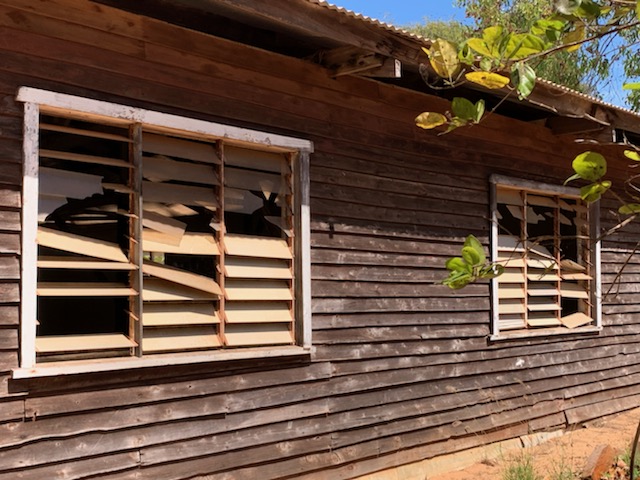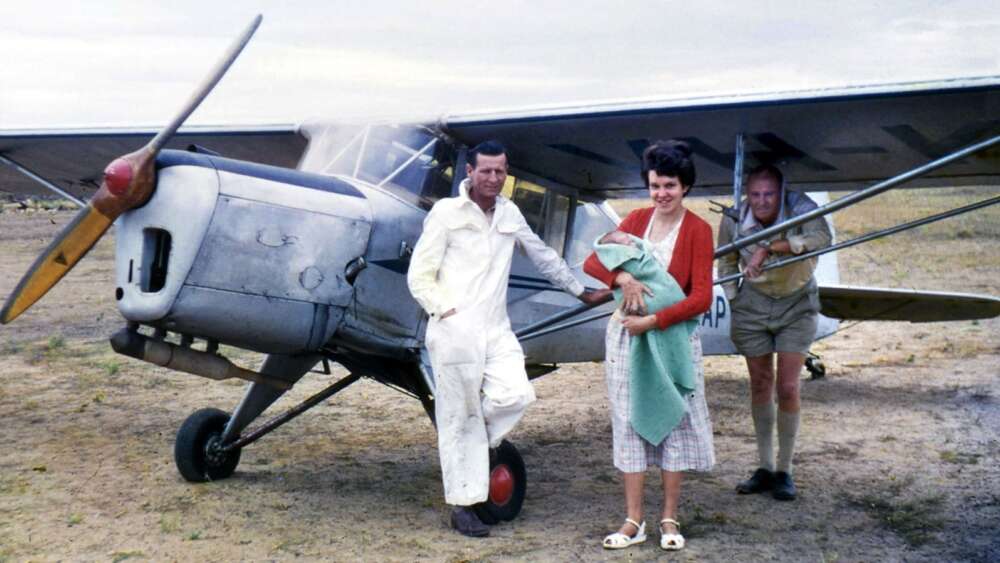When Phil Gilchrist was growing up in the 1960s at Numbulwar, a mostly Aboriginal community on the southeast coast of Arnhem Land, in the Northern Territory, he and his friends would happily swim at the beach and in nearby creeks without any fear of crocodiles.
“Crocodiles just weren’t an issue back then because they were endangered and close to extinction,” recalls the son of Colin Gilchrist, who was the superintendent at the Church Missionary Society Numbulwar Mission from 1959 to 1976.
“We were warned about box jellyfish at the beach and stone fish in the creeks but crocodiles were not a consideration. I don’t think I would venture there now.”
As Numbulwar prepares to celebrate the 70th anniversary of its foundation on August 16, Phil recalls how Foundation Day was celebrated with a combined sports carnival and fete in the early days of the mission.
“We’d go down to the town park, and there’d be all sorts of fun activities happening, running races, tug of war, and we’d finish off with the Indigenous adults having a sports competition like a spear throwing or fire stick lighting competition and I used to look forward to those.”
Phil has nothing but fond memories of his time at Numbulwar, where he spent all his holidays when not at boarding school in Sydney.
“It was a nice place to live and I felt completely known by everybody in the town, white and black, and knew everyone.”

John Mercer, the first Superintendent, taught the young men of Numbulwar, or Rose River as it was called then, how to mill and build with cypress pine.
His happy childhood memories include “playing outdoors for hours at a time with other kids, white and Aboriginal friends. We’d roam the bush, ride our bikes around town, out to the airstrip or the barge jetty.
“A couple of things I loved were the town had an outdoor cinema in those days and it was the town social event every week. Every Saturday the whole town gathered to watch movies. I used to love sitting out in the outdoor cinema with hundreds of other people.”
The diocese is doing what it can to support the church and the Indigenous leaders there.” Lee Walton
In preparation for this year’s anniversary, the NT Anglican Diocese is completing major refurbishments to its historic church and rectory, in consultation with the church leaders, Rev Yulki Nunggumajbarr and deacon Rev Edwin Rami.
“Significant things are happening from a spiritual viewpoint at the moment with large numbers attending Christian fellowship in the town and there’s a real buzz, so the diocese is doing what it can to support the church and the Indigenous leaders there partly by refurbishing the building,” says Lee Walton, the diocese’s property manager.

The windows of the historic Church of The Holy Spirit in Numbulwar are being replaced.
The 1961 Church of the Holy Spirit, which has been badly damaged by environmental factors and vandalism, is getting new windows, strengthening of a badly bowed wall, fixing of internal walls and improving the structure of the roof. The fellowship area where the church meets on weeknights for worship, teaching and general get-togethers is also being refurbished.
“That is in a really poor state, tables are broken, there’s no lighting, no power, so they string a cable from the church and plug in a spotlight and amp. We will put proper lighting out there, refurbish one of the shelters and provide tables and lighting,” says Lee.
Although CMS handed over the administration of the Numbulwar community to the local council in 1978, CMS still has a missionary presence there. Josh and Steph Mackenzie, and their two children, moved in as CMS missionaries at Numbulwar last September.
The couple developed a love for First Nations people while working as teachers on Tiwi Island early in their careers. But they have a remarkable kinship link to Numbulwar. Stephanie is the great-niece of Jane and Colin Gilchrist, and that ancestral link helped the Mackenzies hit the ground running as they arrived in the community already with family connections and skin names.
Their house is also being refurbished with new windows, a new steel beam, an updated bathroom, a strengthened floor, internal and external walls, and a new veranda and steps.

Earl Hughes with Numbulwar children
The mission at Rose River, on the southeast coast of Arnhem Land, has a fascinating history in that it was established in 1952 in response to a request from the Nunggubuyu people themselves. A group of Nunggubuyu had camped close to the mission at Roper River, now known as Ngukurr, during a severe drought, but they wanted a mission on their lands further north.
The Roper River mission and the whole of Arnhem Land had been established half a century earlier to protect Aboriginal people from pastoralists invading their land and from exposure to damaging Western civilisation.
CMS had promised the Nunggubuyu in 1934 that would have their own mission, but the Great Depression, World War II and lack of personnel had frustrated those plans.

John Mercer with a model of the dwellings he built at Numbulwar with help from the community.
Finally, in May 1952, a party of CMS people led by John (Jack) Mercer and about 65 Nunggubuyu people, led by their charismatic chief, Madi Murrungun, set off from Roper River to explore the area around Rose River.
Once they reached the corroboree area on the north side of the Rose River mouth, Madi invited John Mercer to start a mission there. CMS gladly accepted and on 14 August 1952, two boats sailed from Roper River to Rose River, arriving two days later 16 August.
“I started talking in English, and I realised they didn’t understand what I was talking about.” – Earl Hughes
Earl Hughes, who was chaplain to the mission from 1956 to 1972, was a giant in the early days of the mission, a pioneer in understanding the key role of language in building up the spiritual life of the place.
“CMS told me when you go, don’t worry about the language. Teach them English,” recalls Earl, who is now 94.
“When I gave my first service under the paperbark tree, I started talking in English, and I realised they didn’t understand what I was talking about.
“So I got my notebook, and I’d go walkabout with the Aborigines and ask them, ‘What is this?’ And write it down. Eventually, it became quite a big dictionary.”
Earl translated the church services and part of the Bible into Nunggubuyu (now known as Wubuy) with the help of Aboriginal colleagues and compiled a Nunggubuyu Grammar and Dictionary.
“It was through their language that I became a member of their tribe and was treated as one of their members.” – Earl Hughes
John Mercer’s son Paul notes that some of the teaching in the government-run education centre today is in the Nunggubuyu language, thanks to its preservation from this early mission phase, although Kriol is displacing the spoken language among the young people.
Earl was also a pioneer in exploring the tribal lands around Numbulwar, recording their sacred areas and different clan territories. Earl explains that his tribal brother, Dirrijuna Murrungun, taught him a lot. He says his nickname was Ngaralu Murrungun, which means mud crab, because he was famous loving to eat mud crabs.
“It was through their language that I became a member of their tribe and was treated as one of their members,” he explains.
Asked for his fondest memories of his time at Numbulwar, Earl says, “the highlight was when a number of Aborigines decided to become Christians and were baptised in the little creek near the beach. They became the church, and we built a church after that.”
From 1959 to 1960, Earl prepared and baptised 24 Aboriginal people from Numbulwar, then the Church of the Holy Spirit was built and held its first service on 11 January 1961.

Working on the early dwellings
Paul Mercer, who has documented the mission’s early days in his book, Memories and Medicine in East Arnhem Land, says conditions were primitive at first, with accommodation in roofless grass, but his father taught the younger men in the community how to mill and build with the termite-resistant cypress pine of the area to create more substantial dwellings for the coming wet season.
I am aware of the enormous privilege of growing up in this wilderness environment in such a carefree and natural environment.” – Paul Mercer
According to Paul, his father formed a very close friendship with the chief, Madi, who “watched his back” as he led the work of establishing the new township. Jack greeted Madi every morning as “uncle” while Madi called Jack “nephew.”
Paul’s mother, Phyllis initially taught the children under a big paperbark tree which had a natural seating area at the base. This tree, called the bishop’s seat, was also where early Christian worship services and community gatherings took place.
Paul enjoyed watching local people create pictorial stories through bark paintings, making rope and baskets, hunting, spearfishing, and canoe construction.
“It was always exciting as a little boy to go with younger people and discover [turtle] eggs nests,” he writes.
“These were fun-loving people who utilised the natural resources of the beach and the bay at Numbulwar … Hours could be absorbed wandering over the mud flat searching for crabs.
“My childhood through to four years of age was an idyllic one. I am aware of the enormous privilege of growing up in this wilderness environment in such a carefree and natural environment.”
Email This Story
Why not send this to a friend?


